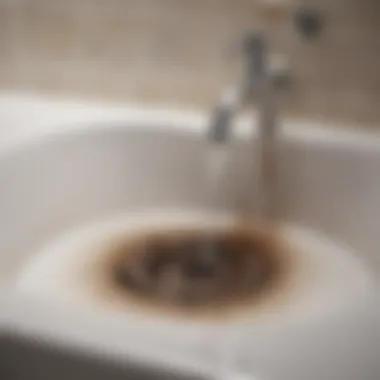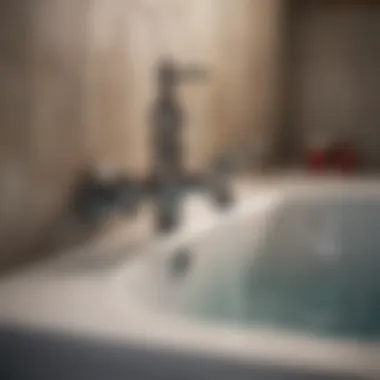Understanding Tub Drain Clogs: Alternative Solutions


Intro
Clogged tub drains represent a frustrating reality for homeowners. While chemical solutions like Drano may seem convenient, they frequently fail to address the core problem underlying the clog. Understanding the nuances of tub drain clogs is essential for effective troubleshooting and management.
Traditional methods often promise quick fixes without exploring the tangible causes of plumbing issues. This article illuminates why such remedies might not always work as anticipated. Additionally, it highlights alternative strategies for tackling stubborn clogs and underscores the necessity of regular plumbing maintenance.
Equipping yourself with practical knowledge will empower you to enhance both the functionality and aesthetic appeal of your home. To this end, let’s explore the intricate relationship between tub drain clogs and maintenance practices.
Prologue to Tub Drain Clogs
Understanding tub drain clogs is crucial for any homeowner. Regular use of bathtubs can lead to various pipe issues, and recognizing the symptoms early can prevent extensive damage. In many cases, clogs are not just inconvenient, but they can also affect the overall sanitation of a home. Addressing this problem promptly is vital for maintaining hygiene and ensuring the plumbing system works efficiently.
The article uncovers the reasons behind these persistent clogs and discusses why popular chemical solutions like Drano may not solve the issue effectively. Knowing what causes clogs can empower homeowners to take preventative steps, saving time and money in the long run.
Understanding Clogs
Clogs in tub drains usually arise from a combination of factors. They can occur slowly over time, often unnoticed until the water drains very slowly or not at all. Various elements contribute to blockage:
- Hair that gathers around the drain
- Soap residues that create buildup
- Foreign objects that may accidentally slip down
- Damaged pipes that hinder normal flow
Signs of a clog often include slow drainage, gurgling sounds, and unpleasant odors. Recognizing these early indicators makes managing the problem simpler and prevents it from escalating.
The Role of Drano in Clog Management
Drano and similar chemical drain cleaners are widely marketed for their ability to clear clogs quickly. These products contain harsh chemicals designed to dissolve materials that obstruct pipes. However, they are not a guaranteed solution for all types of clogs.
The effectiveness of Drano can diminish depending on what is causing the clog. In many situations, it may provide only temporary relief. If a clog is due to factors like hair or soap scum, these cleaners may not dissolve the residue effectively.
Moreover, reliance on Drano can cause harm. Prolonged use of chemical cleaners can corrode plumbing over time, leading to more costly repairs. Therefore, being informed about the limitations of these products is essential for homeowners.
Common Causes of Tub Drain Clogs
Understanding the common causes of tub drain clogs is essential for effective clog management. Frequent clogging can lead to extensive plumbing issues and costly repairs. Knowing the specific elements that contribute to clogs allows homeowners to take proactive measures, reducing the frequency of drainage problems. This section aims to clarify the key culprits behind tub drain clogs, offering insights that are particularly beneficial for those who are passionate about home maintenance and design.
Hair Buildup
Hair buildup is often the leading cause of clogs in tub drains. When hair goes down the drain, it can create a tangled mass over time. This obstruction slows water flow and eventually leads to complete blockage. The problem is exacerbated with hair products and styling tools, as they tend to contribute to the accumulation. Regularly removing hair from the drain can significantly reduce this issue.
Soap Scum Accumulation
Soap scum is another common contributor to tub drain clogs. It forms from the combination of soap residue, body oils, and minerals in water. As soap scum builds up, it coats the inner plumbing and narrows the passage for water to flow through. Over time, this can form a solid barrier that traps hair, dirt, and other debris, worsening the clog situation. Routine cleaning of surfaces and drains helps mitigate this issue.
Foreign Objects


Sometimes items can accidentally fall into the tub drain causing clogs. Things like small toys, cotton swabs, or even jewelry can lead to blockages. These foreign objects can cause immediate and severe clogs that typically require more than just drain cleaning solutions.
Pipe Damage or Deterioration
Pipe damage or deterioration may also be a significant cause of tub drain clogs. Over the years, pipes can corrode or suffer from cracks. This damage can inhibit water flow and create spaces where debris can accumulate. Identifying signs of pipe issues early on helps avoid more serious plumbing troubles in the future. Regular inspections can be beneficial in spotting such problems before they become worse.
When Drano Fails
When faced with the frustration of a clogged tub drain, many homeowners turn to chemical solutions such as Drano. However, this section addresses the limitations of relying on such products and explores scenarios where they might fall short. It outlines critical elements to consider regarding chemical drain cleaners, potential risks to plumbing, and environmental implications.
Limitations of Chemical Drain Cleaners
Drano and similar products can provide quick relief for minor clogs, but their effectiveness is limited. These cleaners often work by using harsh chemicals that dissolve organic matter. Yet, they are less effective against other types of obstructions such as grease or solid objects.
Chemical drain cleaners can also take time to work, leaving homeowners in a prolonged state of inconvenience. Sometimes, they do not penetrate deeply enough to clear the clog, resulting in repeated applications.
Consider the following points about chemical drain cleaners:
- Effective only on specific types of clogs: They may not dissolve hair or heavy soap scum effectively.
- Risk of non-complete blockage removal: If the blockage is not fully cleared, it can lead to more significant issues over time.
- Damage to plumbing: Prolonged use can lead to corrosion and eventual pipe degradation.
This reinforces the idea that while Drano can be a quick fix in a pinch, it is not always a reliable long-term solution.
Potential Damage to Plumbing
The use of Drano can introduce substantial risks to plumbing systems. The high chemical concentration can corrode pipes, especially older, more fragile pipes made from materials such as PVC or metal. The consequences of this type of damage can be severe, leading to costly repairs or even total replacement of plumbing lines.
Notable issues include:
- Pipe corrosion: Chemicals can weaken and damage the structural integrity of pipes.
- Heat production: Chemical reactions can generate heat, potentially leading to pipe warping or melting.
- Incompatibility with certain materials: Some plumbing systems may react undesirably to these harsh substances.
Homeowners must carefully weigh the short-term benefits of chemical cleaners against the long-term risks they pose to their plumbing systems.
Environmental Concerns
In addition to potential plumbing damage, there are environmental aspects to consider when using chemical drain cleaners like Drano. The ingredients in many of these products can be harmful to both human health and the environment. When these solutions make their way into water systems, they can have adverse effects on aquatic life and ecosystems.
Key environmental concerns include:
- Toxic ingredients: Many chemical drain cleaners contain substances that can contribute to pollution.
- Contamination of water sources: Improper disposal can lead to hazardous materials entering natural water bodies.
- Regulatory challenges: Increased awareness has led to more scrutiny and potential regulations governing the use of such products.
It is essential to consider the broader impact of chemical drain cleaners on our environment, alongside their immediate effectiveness.
Navigating clogged tub drains requires a deeper understanding of alternatives and the overall implications of chemical solutions. Awareness of these limitations will equip homeowners with the knowledge necessary for making informed decisions.


Alternative Methods for Clearing Clogs
When tub drains become clogged, relying solely on Drano or similar chemical solutions is often insufficient. This section explores alternative methods for clearing clogs that can prove more effective and less damaging to plumbing systems. Each method is not only beneficial for immediate relief but also may contribute to long-term maintenance of the plumbing system. Understanding these techniques can empower homeowners and design enthusiasts to tackle clogs systematically and effectively.
Manual Removal Techniques
Manual removal is a straightforward and often highly effective method for dealing with tub drain clogs. This process involves physically extracting the debris that is blocking the drain. Tools such as a screwdriver or a specially designed plumbing tool may be necessary for this task.
- Examine the Drain: Begin by inspecting the drain for visible obstructions. Hair, soap scum, and other debris can often be seen or felt.
- Use Gloves: It’s crucial to wear gloves to protect your hands from sharp objects or bacteria.
- Remove the Stopper: Most tub drains have a stopper that can be unscrewed or pulled out to access the interior of the drain.
- Extract Debris: Use a tool or your hand to pull out hair or other clogs. Make sure to dispose of the debris properly.
Manual techniques can clarify the nature of the clog and address it directly without chemicals.
Using a Plunger Effectively
A plunger is a common household tool that can be effective in dislodging clogs if used correctly. To utilize a plunger:
- Prepare the Area: Remove excess water if possible. The plunger works best with some water in the tub to create suction.
- Position the Plunger: Place the plunger directly over the drain, ensuring a tight seal.
- Pump: Push down firmly and pull up rapidly. Repeat this motion several times. The suction created can help in loosening the clog.
- Test the Drain: After several pumps, remove the plunger and check if water drains properly.
This method is both cost-effective and environmentally friendly.
Employing a Drain Snake
A drain snake, or auger, is an essential tool for any plumbing emergency. It is designed to reach deep into pipes to clear stubborn clogs. The use of a drain snake can be broken down into these steps:
- Insert the Snake: Feed the snake into the drain slowly until you feel resistance, indicating that it has reached the clog.
- Break Up the Clog: Turn the handle of the snake to break apart the clog.
- Retrieve the Snake: Pull the snake back out while rotating it to collect any debris attached.
- Flush the Drain: Run water for a few minutes to wash out any remaining particles.
Employing a drain snake can prevent potential pipe damage caused by harsher methods.
Hot Water and Vinegar Solutions
Another alternative involves using simple household items like hot water and vinegar. This method is particularly helpful against grease and soap scum buildup. Here’s how to do it:
- Heat Water: Boil several cups of water but do not use boiling water on PVC pipes as it can warp them.
- Vinegar Application: Pour a cup of vinegar down the drain first. Allow it to sit for 10 minutes.
- Hot Water Follow-Up: Slowly pour the hot water down the drain. The combination can help dissolve clogs effectively.
This method not only clears the clog but is also safer for the environment compared to chemical drain cleaners.
Tip: Regularly using these methods can help prevent future clogs and keep drains functioning smoothly.
By employing these alternative methods for clearing clogs, homeowners can maintain their plumbing efficiently. Each technique presents a viable option for dealing with stubborn drain issues without resorting to harmful chemicals.
Preventative Measures for Future Clogs
Preventing tub drain clogs is crucial for maintaining a smoothly operating plumbing system. The inconvenience of dealing with a clogged drain can be significant, leading to costly repairs and potential water damage. By implementing a few preventative measures, homeowners can minimize the chances of encountering such issues.


Routine Cleaning Practices
Regular cleaning of the tub drain and surrounding areas helps reduce buildup of debris. This can be easily accomplished by regularly removing any visible hair or soap residue. A simple practice is to use a damp cloth or sponge to wipe down surfaces and catch any particles before they go down the drain. Moreover, considering more thorough wet cleaning procedures once in a while can enhance hygiene as well.
Utilizing Drain Strainers
Investing in drain strainers can be an effective barrier against clogs. Placing a strainer over the drain captures hair and larger particles, preventing them from entering the plumbing system. It's important to clean the strainer frequently to maintain its effectiveness. Several options are available, including mesh types or metallic designs, offering a blend of aesthetic appeal and practical usage.
Monitoring What Goes Down the Drain
Being mindful of what goes into the tub drain is essential. Avoid letting substances like grease, excessive soap, or non-disposable items go down the drain. Educating all family members about appropriate items for disposal can help avoid future issues. Furthermore, introducing simple rules, like not rinsing off thick substances directly into the tub, can contribute to a healthier plumbing system.
"By understanding and addressing common contributors to clogs, homeowners can maintain their plumbing systems with ease."
Through these measures, not only can you reduce the risk of clogs, but you also ensure that water flows smoothly, improving the overall functionality of your home's plumbing system.
Professional Help: When to Call a Plumber
Dealing with tub drain clogs can often lead to frustration. When conventional methods like Drano fail, you may wonder if it's time to seek professional assistance. Knowing when to call a plumber is crucial for saving time and preventing further damage to your plumbing system.
Identifying Persistent Problems
Not every clog can be fixed with basic tools or DIY strategies. If you experience repeated clogs, it may indicate a deeper issue within your plumbing. Persistent problems can stem from various sources, such as:
- Old or damaged pipes: Aging plumbing systems may suffer from wear, leading to recurring clogs.
- Tree root intrusion: Roots can invade sewer lines, creating significant blockages.
- Severe buildup: Heavy accumulation of debris that manual methods cannot remove.
If you notice that clogs are becoming a regular occurrence, it’s critical to seek the expertise of a professional. Ignoring these signs might result in more complex plumbing issues later.
Benefits of Professional Services
Engaging professional plumbing services has several advantages:
- Expert Diagnosis: Professionals can quickly identify the root cause of persistent clogs, offering solutions tailored to your specific situation.
- Advanced Tools: Plumbers have access to specialized equipment like video inspection cameras or hydro-jetters that can effectively clear stubborn blockages.
- Preventive Maintenance: A qualified plumber will not only solve your immediate problem but can also recommend preventative measures to help avoid future clog issues.
- Time and Stress Savings: Hiring a professional saves you the hassle of troubleshooting complex plumbing issues. They handle the labor, allowing you to focus on other important responsibilities.
Remember, while DIY solutions can address minor clogs, enlisting professional help is worthwhile when the problem persists or escalates. Your home deserves a plumbing system that functions smoothly and efficiently.
The End
Successfully managing tub drain clogs is not merely about choosing one method of unclogging, such as reaching for Drano. The issue is often more complex. Recognizing the underlying causes of clogs enables homeowners to adopt tailored solutions that are not only effective but also safe for plumbing systems.
Summary of Key Insights
Throughout this article, we explored various aspects of tub drain clogs. Here are some key insights:
- Understanding Clogs: Clogs can arise from multiple sources including hair buildup, soap scum, and foreign objects. Awareness of these causes can aid in prevention.
- Limitations of Drano: While chemical drain cleaners like Drano can be convenient, they have significant limitations including potential damage to plumbing and environmental concerns.
- Alternative Solutions: Techniques such as manual removal, plunging, and employing drain snakes provide more effective results in many instances.
- Preventative Measures: Adopting routine cleaning, utilizing drain strainers, and being mindful of what goes down the drain can dramatically reduce the likelihood of future clogs.
By assimilating this knowledge, homeowners can ensure that their plumbing systems remain functional, minimizing the risk of recurrent clogs.
Encouraging Ongoing Maintenance
Continuous maintenance is crucial for sustaining a clog-free tub drain. Homeowners should establish a routine to ensure their plumbing remains in optimal condition. Regularly clearing hair from strainers can be a simple yet effective step. Additionally, periodic cleaning using natural solutions, such as vinegar and baking soda, can help maintain clear pipes without resorting to harsh chemicals.







